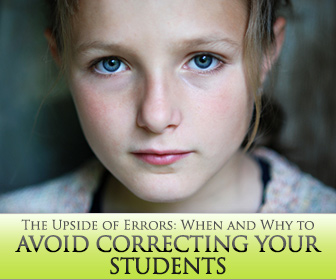The Upside of Errors: When and Why to Avoid Correcting Your Students


Teach a man to fish and he eats for a lifetime. That’s the basic mindset behind self-correction – teaching students to recognize and fix their own mistakes. Giving teacher feedback is good and necessary while they are in your class, but giving your students the tools to correct themselves is even more important for a lifetime of language use. That way when your students move the tassel from one side of the cap to the other, they will still be able to speak with accuracy and fluidity (and fix errors in their spoken English on their own). So how does an ESL teacher teach her students how to self-correct? Here are some strategies you should try.
Yes, that’s right. Sometimes the most effective feedback you can give your student when they make a mistake is to do absolutely nothing. Maintain eye contact as if waiting for them to continue after they make a mistake. When you do, the silence in the conversation will signal your student that something is wrong, and the feedback mechanism in the brain will kick in and review what they just said. Often that is enough for your ESL student to find her mistake and correct it. If not, you can try prompting her a little more directly. Repeat what she said up until the mistake and then wait. For example, if she said, “I will go to the mall in Sunday.” You might follow up by saying, “You will go to the mall…” That will signal where the mistake in the sentence occurred and help your student pinpoint what they need to correct if they didn’t discover it during your intentional silence.
If you have taught for any length of time, you have seen that speakers of certain first languages tend to make the same mistakes when learning English. For example, Japanese students often drop their articles or the plural -s when they are learning English. You can put your native Japanese speaking students on their guard for these errors by simply pointing out the tendency. Take your Japanese students aside and teach them the errors common for Japanese speakers learning English. Then encourage them to pay particular attention to those areas of English when they talk. On another day, take your Spanish speakers aside and point out to them the errors that native Spanish speakers tend to make while learning English. You can do this for every group of first language speakers in your class. And if you are teaching English overseas and your entire class speaks the same first language, do the lesson as an entire class. Just by pointing out what to look for, your students will be able to avoid many mistakes that might otherwise trip them up.
As teachers, we naturally fall into the trap of doing too much talking. We are the ones with the information. We know what our students need to learn. (We have to cover the material on the syllabus.) All of this can make for a very teacher centered class – one where you are the focus. A better atmosphere in an English as a second language class is a student centered class. This means that your students are the main focus in class. They do most of the talking. They are up front. They take a greater part in their own learning. And as a result, they will take a greater part in making sure their English is correct. When students are constantly looking to you for approval, direction, and correction, they will also look to you to find their mistakes, and their awareness of their own errors decreases. So be sure that your class is student centered, that you keep teacher talk time to a minimum, that your students are speaking to each other more than they are speaking to you, and that your students have some input as to what you do in class. In so doing, they will take greater responsibility for their language learning including correcting their own mistakes.
How can students look up correct information in English if they don’t understand how to use a dictionary? And by dictionary I mean an English only dictionary, not a translator. Teach your students how to check a dictionary to learn or confirm spelling. Show them how words are arranged on the page. Teach them the system by which word pronunciation is notated in the dictionary. If you can, teach them English phonics which will help them spell out and then locate unfamiliar words. It will take some time at the start to teach your students how to smoothly navigate a dictionary. But if you take the time up front, it will pay off in the long run when your students are able to identify and correct the words they hear and use.
You might be surprised how many habitual student errors can be dealt with by having students correct sentences at the start of your class period. They key is getting the right sentences on the board for students to correct. Pay attention to the errors you hear from your students. Make note of the exact sentences they use. (Try jotting them down on a sticky note when you hear them and then coming back to them at a later time.) Then put one or two of those sentences on the board each day. Don’t say where they came from. Just tell your students that the sentences contain errors and they should correct those errors. If you like, tell students just how many errors are in each sentence. This process will give you a quick and easy way to clarify grammar points and make students are more aware of those same mistakes. After using this system for a while, you will see student errors decrease and self-correction of those errors increase.
Policing is probably too strong a word to describe having your students note the errors of their classmates. Perhaps monitor is a better choice. Regardless of what you call it, putting your students in charge of finding errors in their classmates’ speech will increase self-correction among your entire class. The next time you are doing a group speaking activity such as a discussion, put one person in each group in charge of noting the errors the members of his group make while they discuss. After the discussion, ask each of your monitors to share some of the errors they heard without sharing the name of the person who made the error. You can take a mere ten minutes or up to thirty minutes or longer to discuss the errors your students made during their discussion period. When the monitor makes a point of noticing errors in others’ spoken English, they will naturally become more aware of errors in their own as well. Make sure you rotate the monitoring responsibility so all of your students get a chance to play good cop (or bad cop), and you will see a positive effect on each person’s ability to self-correct.
And if you are a pro, I hope I’ve given you a few new ideas to promote it among your students. Remember our goal as educators is to make independent, self-sufficient speakers of English, and part of that is making sure our students can correct themselves.